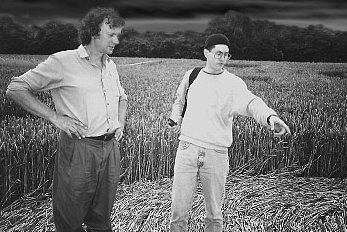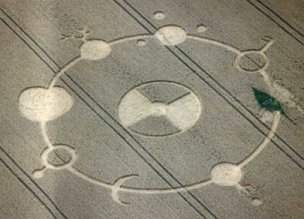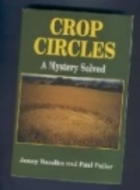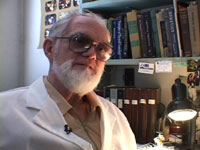An article by Paul Fuller, in his crop circle bulletin The Crop Watcher, #23, autumn 1994.
Yet another major controversy has hit the troubled world of "cereology" with the publication of the H-Glaze Report by Dr W.C. Levengood and his co-worker John A. Burke, in the United States. Readers will already know from lengthy articles in The Cerealogist and The Circular about the controversial work being conducted by Dr W.C. Levengood and John A. Burke at Pinelandia Biophysical Laboratories (an impressive sounding name, but in fact merely a laboratory attached to Dr Levengood's private address). Over the past few years a number of "Lab Reports" have been issued proclaiming the latest discoveries by these researchers. As someone with postgraduate training in experimental design methods I was naturally interested in what Levengood and Burke have been up to !
In "Lab Report No 18" Levengood and Burke describe what they call a "Technique for Examining Crop Circle Energetics". Readers will recall that one of the major criticisms made against the crop circle researchers by sociologists in the "Equinox" documentary was this vague use of that term "energy". So far my attempts to find out what kinds of "energetics" are being analysed by Levengood and Burke have met with failure. In the meantime it is perhaps safe to say that as a professional statistician I found their description of their methodology confusing and disquieting.
Levengood and Burke claim that they have developed two verification methods that are capable of distinguishing "genuine" crop circles from fakes. These two tests are the amplitude coefficient (also referred to as the "alpha test") and the use of seedling development rates (ie growth rates). These tests have apparently indicated that "something is altering the rate at which ions flow through the affected crop". Levengood and Burke state that they have established that trampling cannot produce the statistical results they are discovering in "genuine" circles because they have compared their test results with results produced by provably man-made circles. Strangely, this finding didn't stop them from promoting crop taken from Jim Schnabel's Dharmic Wheel as genuine products of the rapid heat-inducing circle-making mechanism.
In this reviewer's opinion, there are many problems with the claims made in Lab Report No 18. To begin with, Levengood and Burke appear to confuse the terms "sample" and "population". Also, they appear to have exaggerated the importance of the results they have obtained. Quoting chances of "less than one in a million" for their test results Levengood and Burke do not appear to appreciate that it is inappropriate to calculate binomial probabilities when ratio data is available.
Reading through Lab Report No 18 I must admit that I have found it difficult to understand how these two researchers have analysed their data. They claim that
"Each sample run involves five alpha values per trace. The current procedure involves six replicate tests on individual bracts (each selected from a different plant if available). Controls and crop circle samples are ran [sic] in alternate tests. The 30 data points (alphas) are entered into a computer program ("Statview") which provides a convenient means of statistically analysing many aspects of the data population. The most reliable, consistent information from the thirty alpha values is based on a statistical analysis of the paired, thirty data point alpha populations".
Again Burke and Levengood use the term "population" when they mean "sample". I have read this statement over and over again, and I still don't understand how one can apply a "paired" analysis of "six replicate tests" on each plant. A "paired" analysis involves comparing two values, not six !
The correct method of analysing the kind of data discussed in Lab Report No 18 is to conduct a two-way analysis of variance. In this way one can test whether or not there are statistically significant differences between samples of crop taken inside the formation and samples of crop taken from outside formations, taking into account the natural variations in the alpha values of samples in both groups. Such an analysis would only be representative of crop circles in general if the samples taken were truly independent of each other within each formation and if these tests were repeated in numerous formations chosen at random across the world. Unfortunately Lab Report No 18 examines samples taken from just one formation, the 1993 ringed circle in oats at Albertsville in Canada.
Unfortunately, by taking "six replicate tests" on the same plants it is debatable whether or not these researchers have collected a truly random sample. For this reason not only have Levengood and Burke conducted the wrong statistical test but they may well have invalidated any results they obtain because they failed to satisfy one of the primary assumptions underlying almost every statistical test ever conducted !
However, the greatest problem with Lab Report No 18 is Levengood and Burkes' curious decision to alter PROX-10 from a control reading into a circle reading in their Figure 4 (approximately reproduced in Figure 1 on page 6). This decision cannot possibly be justified because it completely alters the outcome of the results of the alpha test !
In the top half of Figure 1 we have reproduced Levengood and Burkes' results by drawing the average alpha value for each sample. Levengood and Burke have drawn a line through the highest control average (Cont-7) to emphasise how all the average alpha values taken inside the circle and ring are higher. However, this decision ignores the fact that PROX-10 - a sample taken in unaffected crop close to the formation - produces an average alpha value which is higher than four of the six circle and ring samples !
If we redraw Figure 1 by correctly treating PROX-10 as a control sample (rather than a sample taken from inside the formation), then the true test result becomes clear. There is little evidence that the average alpha values are significantly higher inside the circles and rings than in surrounding, untouched crop. In other words, the alpha test provides no evidence of unusual effects. This decision to alter PROX-10 from a control sample to a "circle" sample is scientifically dishonest, for it alters the whole outcome of the experiment. It is true that two of the alpha values are higher than the PROX-10 average (CIR-1 and RING-6), but in this reviewer's opinion it must surely be expected that a two-way analysis of variance will demonstrate that there is no statistically significant difference between the average alpha values found inside the formation and those found in the surrounding crop. I say this because it is clear that there are wide variations between the average alpha values in both groups (e.g. the average alpha readings in the control samples vary from approx. 0.022 and 0.075, whilst the average alpha values of samples taken within the circle vary from 0.038 to 0.090).
Unfortunately Levengood and Burke have failed to publish the data they used in Lab Report No 18 so I cannot test this conclusion properly.
The True Extent of Hoaxing
One of the problems with this research is that it is apparent from their own published work that Levengood and Burke seem blithely unaware of the true extent of hoaxing in Britain. Levengood's recent promotion of Jim Schnabel's Dharmic Wheel formation seems an excellent example of the way in which the crop circle myth continues to flourish because of the mass suppression of pro-hoax evidence by leading cerealogists. Of course Levengood and Burke claim to be searching for an infallible method of distinguishing real from fake - something we would all love to see - but this is no excuse for not having done their homework on recent events.
This article by Paul Fuller, "Dr W.C. Levengood, John A. Burke, Lab Report No 18, the FE3 Project and the H-Glaze Report" includes two critical reviews of two BLT reports. Only the first is published here, the one about the "Lab Report No 18". The part about the relating to the "FE3 Project and the H-Glaze Report" is here.
For clarity's sake, some information on the context at the time when this article was published and on the involved people is useful.
Chronology:
The first crop circles were made in 1978 by Doug Bower and Dave Chorley, they really caught the attention only in 1980. Bower and Chorley continued to make crop circles until 1991, when they revealed that they did it, that is to say three years before the publication of the above article.
At the time when this article was published, British ufologists had already realized that the crop circles were by no means traces of flying saucers landings, that aliens did not create crop circles. They had realized that prankster could do them, but everyone had not understood that it was not nothing more than that: just a huge prank.
More or less gonzo researchers or apparently "serious" researchers had split into two enemy clans indulging in a merciless war, often by cheap shots and innuendo more than by the use of well-founded argumentation. The two clans did not deny the reality of pranksters action, but considered with more or less conviction that there nevertheless were or could be "genuine" crop circles, i.e. "crop circles not made by men".
These two clans were the Meadenites and the Delgadonians. The first still believed in a theory put forth by a meteorologist, Dr. G. Terence Meaden, who became convinced that in addition to the man-made crop circles, there were other, "true" crop circles, that resulted from "atmospheric whirlwinds". The idea seemed attractive to some people initially, but actually, it sank in the purest ridiculous as the circle makers fooled Meaden by creating crop circles that ridiculed his theory. For example when Meaden claimed that crop circles were made by whirlwinds, and that this was "proven" by the fact that the crop was always flattened in clockwise manner, Bower and Chorley immediately made anti-clockwise crop circles. When it was told that some people saw mysterious lights, or "UFOS", in the fields where the crop circles were found, Meaden arranged his "wind vortex" theory by claiming that the vortex must have been charged with static electricity, so that it became luminous, and was mistaken for a UFO. These UFOs, quickly called "plasma", had the suitable flavor of "natural phenomena", and with Meaden's "scientific" aura, some BUFORA ufologists became fond of it, as it fitted their view that UFOS were something real and serious, but nothing extraterrestrial. Meadenites, essentially BUFORA members, thus posed as "scientifically-minded ufologists" who "did not believe in little green men" but were neither "vile debunker" who would just "deny the UFO reality".
These Meadenites were in constant struggle with the Delgadonians. The latter were the original "crop circles experts" such as Pat Delgado and Colin Andrews, who had convinced themselves that crop circles were made by aliens, and claimed that the "genuine" crop circles differed from the "hoaxed" crop circles made by men. Their tribune was the Flying Saucer Review and numerous "research" associations with their "cereology" bulletins. It was these people who little by little built up the "crop circles mystery" in a true business, an entire market of books, magazines, conferences, VHS tapes, then CD and DVDs, and it is their shameless exploitation of the popular gullibility that prompted Bower and Chorley to reveal that they were the men who really invented and made the crop circles, and created followers that made even more crop circles in England and around the world.
The people:

|
Jim Schnabel (on the right), 1992, showing parapsychology expert Rupert Sheldrake a crop circle he just did. Sheldrake organized a crop circle making competition, thinking that the result would disprove that pranksters could make the crop circles, but he was proven wrong.
Jim Schnabel was a young US freelance writer who got interested in crop circle lore. Like many other outside the Meadanites and Delgadonians, he wanted to check for himself whether it was truly so difficult to create a crop circle and found out it was easy. He made a number of crop circles such as the "Dharmic Wheel", that the so called "experts" then pronounced "genuine". He wrote the book "Round in Circles" in 1994, in which he tells the history of the people involved in the so-called "crop circle research" in England.

|
Jim Schnabel's 1992 crop circle in Silbury Hill, named the "Dharmic Wheel" and pronounced "genuine" by Michael Green, the then Chairman of the "International Centre of Crop Circle Studies".
Paul Fuller, BUFORA ufologist, was a keen Meadenite. To his credit, he was never unaware of and never denied the role of the pranksters, contrary to the Delgadonians. On the other end, he insisted well too long in promoting Meaden's "plasma vortex theory", although it was just eccentric pseudo-science. He finally recognized and admitted that pranksters are the only explanation, and that whirlwinds, luminous or not, had no real part in the appearances of crop circles.

|
Above: Cover of the Jenny Randles and Paul Fuller 1993 book "Crop Circles: A Mystery Solved". The writers thought that they had "astonishing new evidence that a hitherto unknown atmospheric force is responsible... Using established scientific techniques, they go on to argue that rare meteorological data - such as ball lightning and electromagnetic clouds - can account for all the classic cases of 'alien' literature, and signal the death of the UFO, as popularly conceived."
William Levengood, in United States, was a retired laboratory assistant who became impassioned with the crop circles mystery, and "analyzed samples" generally sent from England by Delgadonians. In his article, Paul Fuller does note that Levengood's laboratory has an impressive sounding name but is actually just an annex of his private home, but he views Levengood as probably sincere. Paul Fuller did not know then what was revealed much later: Levengood had simply usurped his "Doctor" title. He never had a PhD, he just made it up for better impressing the ufologists that attended his lectures and read his articles. This is why this "doctor" title appears in Fuller's article and later disappeared in the crop circles proponent literature. Had Fuller known about that, he would perhaps not have been so convinced of Levengood's sincerity.
William Levengood, self-claimed "doctor", had around him what sounded like a true institute of "scientific" research with all the required smell of serious, called BLT. The acronym simply means Levengood, Burke, Talbot. Actually, Burke was primarily the money provider, and Nancy Talbot a nice lady with an education in psychology but without any scientific competence in plants or UFOs, who essentially is BLT's head and public relations person, and put forth all sorts of weird and far-fetched ideas of the "New Age" king on the crop circles with a rather scary gullibility.

|
Nancy Talbot.
She thinks UFOs and crop circles are "something" that has to do with "consciousness" and that "90%" of the crop circles are "genuine".

|
Levengood claimed crop circles are created by ionized air vortex created when meteorites fall, Burke claims crop circles are created by plasma vortexes.
BLT's "works" thus became the "scientific reference" of the credulous people who were unable of critical thinking, who did not check anything, who, all over the world still believe, and want to make believe, that some crop circles are made by aliens, or that they are alien messages, or created by "psychic powers" etc. But these alleged "scientific analyses" do not resist even a quick examination, and Paul Fuller provided here a telling example:
"Technique for Examining Crop Circle Energetics," the "Lab Report No 18" signed by William Levengood, on October 12, 1993, is just false: Levengood quite simply confused his samples and counted as "sample of plants taken in a crop circle" a sample which was a control sample, i.e. plants taken outside the crop circle!